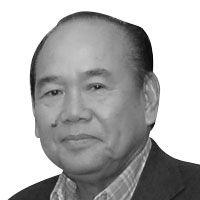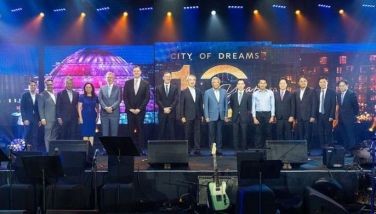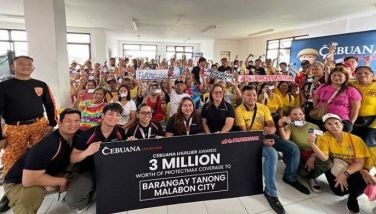A bit of sunshine in our midst

February 14, 2003 | 12:00am
We have been discussing a lot lately about how bleak the local economic scenario is. Criticisms, which are very easy to make, are flying around about failure of government and private sector to collaborate and act positively to resolve several issues negatively affecting the economy. Today, let’s take a look at a bit of sunshine peeking through the overcast skies of our economic landscape. Let me refer you to the seaweed industry sector.
The initiatives taken by the Seaweed Industry Association of the Philippines (SIAP) to push for the acceptance of carrageenan or processed seaweed in the global market as a food grade product fit for human consumption is worthy of emulation by other private sector groups.
Instead of constantly complaining about government’s lack of support, as most industries are wont to do, SIAP forged its battles almost independently, with minimal support from government.
It is a fact that without the intense lobbying and funding of SIAP, the battle could have been lost altogether. The SIAP experience is a good example of how the private sector and government could work well together to bring the country forward.
Today, the local seaweed industry continues to be a sunshine industry, and the Philippines is now the world’s leading producer of eucheuma seaweeds —— the kind that yields carrageenan —— accounting for about 80 percent of total world supply.
Seaweed farming creates jobs and generates steady income for thousands of seaweed farmers in Palawan, Cebu and in Mindanao who were previously engaged in dangerous and destructive dynamite fishing.
But the road to success was not always easy. SIAP, led by Benson Dakay who owns Shemberg Marketing Corp. (SMC), tells its long struggle in the fight for the Philippine seaweed industry’s legitimacy.
In the 1980s, the European Union (EU) banned the use of processed eucheuma seaweed in the processed food industry. This started the long-drawn and costly campaign to prove that Philippine natural grade carrageenan (PNGC) is a safe food additive.
The Philippine seaweed industry lost its market when the EU proclaimed that PNGC was toxic to humans when consumed at certain levels. This was obviously a plot set to block the product that was nibbling steadily into its European competitors’ market share.
SIAP, which represented the seaweed producers in the Philippines, previously never bothered to enlist government help as it pursued its international trading activities. The organization, however, had an embarrassing and unsettling experience when it knocked on the doors of the Codex Alimentarius Commission (CAC) and its Codex Committee on Food Additive and Contaminants (CCFAC) to oppose the ban on the seaweed product.
(CAC is the international body tasked with developing a food code known as the Codex Alimentarius, the global reference point for harmonized or uniform food standards to ensure the protection of public health and fair practices in the food trade.)
SIAP learned rather belatedly that CAC and CCFAC could not hear them out if no official government panel would represent the private business group. After some prodding, government agreed to assist SIAP in its battle. While government gave SIAP the legal face, it was still the latter that spent for most of the staggering expenses needed to keep the campaign going.
With open hostilities on the European front barely starting, US competitors reared its ugly head. In 1992, American firms FMC Marine Colloids Corp. and Hercules Inc. petitioned the US Food and Drug Administration (USFDA) to disqualify the Philippine carrageenan as a food additive.
Again, it was because the Philippine product was gaining market share at alarming levels. The Philippine made seaweed product was encroaching on the two American firms’ traditional markets such as: processed poultry, hamburger patties, dairy products such as milk and ice cream, and chocolates.
This time, government quickly responded by providing assistance. Hearings were conducted from 1993 to 1996 before the US Congress and the USFDA. Then Philippine Ambassador to the US Emmanuel Pelaez provided priceless support as he made sure that the Philippine position was heard, and heard well.
With government constrained by budgetary limitations, the seaweeds industry group responded by providing the resources for retaining US lobbyists as well as the legal staff working in the tedious hearings and presentations.
In 1996, the USFDA threw out the petitions of FMC and Hercules. The USFDA approved carrageenan as food additive and gave it a GRAS (generally regarded as safe) classification.
On the EU front, FMC and Hercules also intensified their campaign against the Philippine product. However, the CAC and CCFAC likewise upheld the Philippine carrageenan. Armed with the double endorsements, SIAP and the Philippine government brought the acceptance campaign to the European Parliament.
After a series of discussions, the European Parliament approved in October 1996 the Philippine carrageenan as a food additive for use in its single market. The Council of Ministers, likewise, approved a resolution accepting the seaweed derivative as a food additive.
Even the European Commission Scientific Committee for Food, composed of 15 eminent food scientists and toxicologists, gave carrageenen the highest safety ranking of "quantum satis" for use in individual food preparation.
The United Nations’ Food and Agriculture Organization (FAO) and the World Health Organization (WHO) joint expert committee on food additives also reevaluated carrageenan at their 57th meeting in 2001, and gave it its highest rating by adjudging it as totally safe for human consumption.
By taking a keen interest in its survival and competitiveness in the world market, the seaweeds producers represented by SIAP was able to effectively fence off attempts to belittle its product.
Philippine businesses need to find ways to fend for itself in the global trade arena if it expects to emerge victorious against its competitors. Government has many other battles to fight, and the competitiveness of local industry is just one of them. Learn from the experience of the seaweeds sector. Learn to fight your own battle, because the government intervention you wish for may never come.
"Isyung Kalakalan at Iba Pa" on IBC-13 News (5 p.m. and 10:30 p.m., Monday to Friday) continues to present other nagging issues that affect the everyday lives of the common tao. Watch it.
Should you wish to share any insights, write me at Link Edge, 4th Floor, 156 Valero Street, Salcedo Village, 1227 Makati City. Or e-mail me at [email protected]. If you wish to view the previous columns or telecasts of "Isyung Kalakalan at Iba Pa," you may visit my website at http://bizlinks.linkedge.biz.
The initiatives taken by the Seaweed Industry Association of the Philippines (SIAP) to push for the acceptance of carrageenan or processed seaweed in the global market as a food grade product fit for human consumption is worthy of emulation by other private sector groups.
Instead of constantly complaining about government’s lack of support, as most industries are wont to do, SIAP forged its battles almost independently, with minimal support from government.
It is a fact that without the intense lobbying and funding of SIAP, the battle could have been lost altogether. The SIAP experience is a good example of how the private sector and government could work well together to bring the country forward.
Today, the local seaweed industry continues to be a sunshine industry, and the Philippines is now the world’s leading producer of eucheuma seaweeds —— the kind that yields carrageenan —— accounting for about 80 percent of total world supply.
Seaweed farming creates jobs and generates steady income for thousands of seaweed farmers in Palawan, Cebu and in Mindanao who were previously engaged in dangerous and destructive dynamite fishing.
But the road to success was not always easy. SIAP, led by Benson Dakay who owns Shemberg Marketing Corp. (SMC), tells its long struggle in the fight for the Philippine seaweed industry’s legitimacy.
The Philippine seaweed industry lost its market when the EU proclaimed that PNGC was toxic to humans when consumed at certain levels. This was obviously a plot set to block the product that was nibbling steadily into its European competitors’ market share.
SIAP, which represented the seaweed producers in the Philippines, previously never bothered to enlist government help as it pursued its international trading activities. The organization, however, had an embarrassing and unsettling experience when it knocked on the doors of the Codex Alimentarius Commission (CAC) and its Codex Committee on Food Additive and Contaminants (CCFAC) to oppose the ban on the seaweed product.
(CAC is the international body tasked with developing a food code known as the Codex Alimentarius, the global reference point for harmonized or uniform food standards to ensure the protection of public health and fair practices in the food trade.)
SIAP learned rather belatedly that CAC and CCFAC could not hear them out if no official government panel would represent the private business group. After some prodding, government agreed to assist SIAP in its battle. While government gave SIAP the legal face, it was still the latter that spent for most of the staggering expenses needed to keep the campaign going.
Again, it was because the Philippine product was gaining market share at alarming levels. The Philippine made seaweed product was encroaching on the two American firms’ traditional markets such as: processed poultry, hamburger patties, dairy products such as milk and ice cream, and chocolates.
This time, government quickly responded by providing assistance. Hearings were conducted from 1993 to 1996 before the US Congress and the USFDA. Then Philippine Ambassador to the US Emmanuel Pelaez provided priceless support as he made sure that the Philippine position was heard, and heard well.
With government constrained by budgetary limitations, the seaweeds industry group responded by providing the resources for retaining US lobbyists as well as the legal staff working in the tedious hearings and presentations.
In 1996, the USFDA threw out the petitions of FMC and Hercules. The USFDA approved carrageenan as food additive and gave it a GRAS (generally regarded as safe) classification.
After a series of discussions, the European Parliament approved in October 1996 the Philippine carrageenan as a food additive for use in its single market. The Council of Ministers, likewise, approved a resolution accepting the seaweed derivative as a food additive.
Even the European Commission Scientific Committee for Food, composed of 15 eminent food scientists and toxicologists, gave carrageenen the highest safety ranking of "quantum satis" for use in individual food preparation.
The United Nations’ Food and Agriculture Organization (FAO) and the World Health Organization (WHO) joint expert committee on food additives also reevaluated carrageenan at their 57th meeting in 2001, and gave it its highest rating by adjudging it as totally safe for human consumption.
Philippine businesses need to find ways to fend for itself in the global trade arena if it expects to emerge victorious against its competitors. Government has many other battles to fight, and the competitiveness of local industry is just one of them. Learn from the experience of the seaweeds sector. Learn to fight your own battle, because the government intervention you wish for may never come.
Should you wish to share any insights, write me at Link Edge, 4th Floor, 156 Valero Street, Salcedo Village, 1227 Makati City. Or e-mail me at [email protected]. If you wish to view the previous columns or telecasts of "Isyung Kalakalan at Iba Pa," you may visit my website at http://bizlinks.linkedge.biz.
BrandSpace Articles
<
>
- Latest
- Trending
Trending
Latest






















